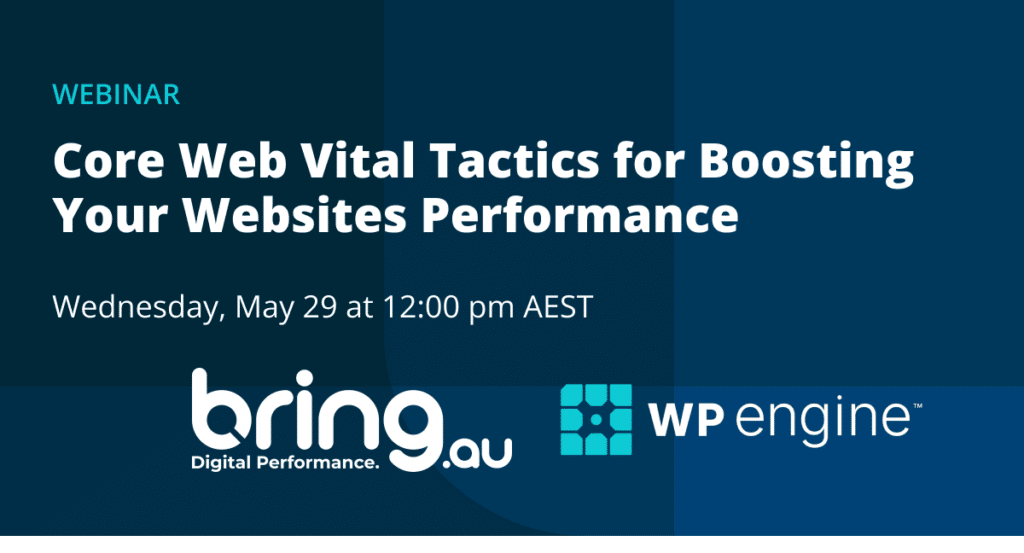In today’s rapidly changing SEO landscape, staying updated with the latest trends is crucial for any digital strategist. Among these trends, Google’s Core Web Vitals (CWVs) have emerged as key indicators of website health, influencing user experience and search engine rankings. This post explores the critical role of CWVs in SEO and how your web hosting choice can dramatically optimise these metrics. For a more comprehensive guide on CWVs, please read our detailed blog post, Understanding and Optimising Google’s Core Web Vitals for Enhanced Website Performance.
WPEngine Core Web Vitals Webinar Recording
Grab some lunch, put the kettle on, and settle in for a 60-session session on how you can begin to improve your website’s CWVs and boost its organic search presence, particularly in Google News and Google Discover.
Understanding Core Web Vitals:
Google’s Core Web Vitals are essential metrics that measure the user experience on your website, focusing on three main areas:
- Largest Contentful Paint (LCP): This metric evaluates the loading performance, with the goal for LCP being under 2.5 seconds from when the page starts loading.
- Example: Imagine an e-commerce website like Amazon. If the product images and descriptions take longer than 2.5 seconds to load, potential customers might leave the site, resulting in lost sales. A fast LCP ensures that crucial content is visible quickly, keeping users engaged.
- First Input Delay (FID): FID measures responsiveness, aiming for less than 100 milliseconds to ensure users can interact with your page quickly.
- Example: Consider a banking app where users need to log in quickly. If the login button takes too long to respond, users may get frustrated and abandon the site. A low FID ensures that actions like clicking buttons or entering data are smooth and responsive.
- Cumulative Layout Shift (CLS): CLS gauges the visual stability of your website, with a recommended score below 0.1 to prevent annoying content shifts.
- Example: Picture reading an article on a news website. If ads or images load later and shift the text while you’re reading, it disrupts the experience. A good CLS score ensures that content stays stable as it loads, making for a more pleasant reading experience.
The Importance of CWVs in SEO:
CWVs are not just technical jargon but crucial to how visitors perceive your site. Here’s why they are indispensable for SEO success:
- Enhanced User Experience: Google rewards websites with superior user experience, making CWVs a significant ranking factor.
- Example: Websites like Google Search prioritise speed and responsiveness, setting an industry standard. When sites like these meet CWV standards, they provide a seamless experience that keeps users returning.
- Lower Bounce Rates: Websites that load quickly and interact smoothly retain visitors longer, which can lead to higher conversion rates.
- Example: An online retailer like ASOS can see lower bounce rates and higher sales when their site loads quickly and users can interact with it without delays. This keeps users shopping and exploring more products.
- Competitive Edge: Staying ahead in CWVs can set you apart from competitors and directly impact your visibility in search results.
- Example: If two travel blogs have similar content, the one with better CWV scores will likely rank higher on Google, driving more organic traffic and engagement.
How Web Hosting Impacts Core Web Vitals:
The choice of web hosting significantly affects your website’s performance concerning CWVs:
- Server Response Time: Premium hosting solutions like WP Engine optimise server response times, enhancing LCP.
- Example: A blog hosted on WP Engine might load its main content in under 2 seconds compared to 5 seconds on a generic hosting service. This faster response keeps readers from getting impatient and leaving.
- Content Delivery Network (CDN): Implementing a CDN can speed up content delivery globally, improving both LCP and FID.
- Example: Streaming services like Netflix use CDNs to ensure their content is delivered swiftly to users worldwide, reducing load times and providing a smoother viewing experience.
- Resource Optimisation: Proper resource management reduces render-blocking elements, improving FID and minimising CLS.
- Example: News websites like BBC ensure that scripts and stylesheets are optimised so articles load fast and stay stable, preventing layout shifts that can annoy readers.
Highlighting WP Engine:
WP Engine provides specialised hosting solutions tailored to improve CWVs through:
- Advanced Caching: Reduces load times, boosting LCP.
- Example: WP Engine’s advanced caching can load a blog post almost instantly, ensuring readers stay engaged from clicking the link.
- Robust CDN Integration: Ensures fast, reliable content delivery.
- Example: A global e-commerce site can use WP Engine’s CDN to deliver product pages swiftly to users worldwide, enhancing their shopping experiences.
- Seamless Updates and Security: Maintains site integrity, aiding in consistent FID and CLS scores.
- Example: Regular updates and strong security measures prevent disruptions, ensuring that a business site remains responsive and visually stable for users.
Optimising Core Web Vitals is paramount for SEO and user satisfaction. Understanding these metrics and choosing the right hosting service can significantly enhance your site’s performance and user experience.
For a deeper dive into Core Web Vitals and more detailed optimisation strategies, check out our existing blog post: Understanding and Optimising Google’s Core Web Vitals for Enhanced Website Performance.
